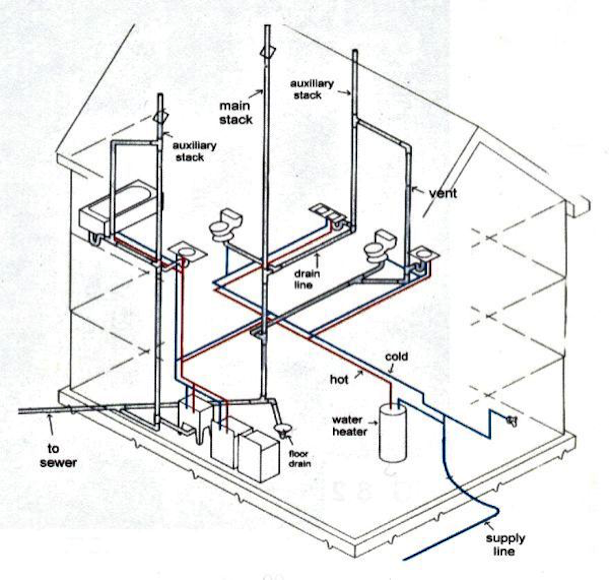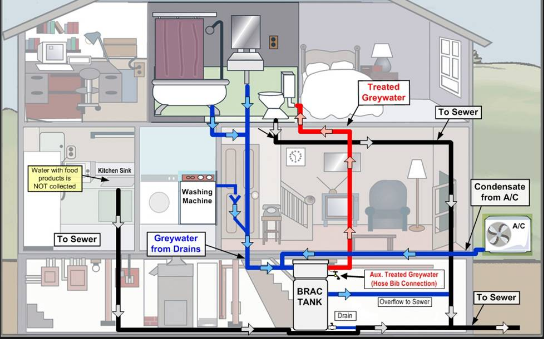We've noticed the article involving Anatomy of a House: Understanding the Components down the page on the net and concluded it made perfect sense to relate it with you on my blog.

Understanding how your home's plumbing system functions is necessary for every single homeowner. From providing tidy water for drinking, cooking, and showering to safely getting rid of wastewater, a well-maintained plumbing system is vital for your family's health and wellness and comfort. In this detailed overview, we'll explore the elaborate network that makes up your home's pipes and deal pointers on maintenance, upgrades, and managing usual problems.
Introduction
Your home's pipes system is greater than just a network of pipes; it's a complicated system that guarantees you have accessibility to tidy water and reliable wastewater elimination. Recognizing its components and how they collaborate can help you avoid expensive repair services and make certain everything runs smoothly.
Basic Parts of a Plumbing System
Pipelines and Tubes
At the heart of your plumbing system are the pipes and tubes that carry water throughout your home. These can be made of various materials such as copper, PVC, or PEX, each with its benefits in regards to resilience and cost-effectiveness.
Fixtures: Sinks, Toilets, Showers, etc.
Fixtures like sinks, bathrooms, showers, and bathtubs are where water is used in your home. Understanding how these fixtures connect to the plumbing system helps in diagnosing troubles and intending upgrades.
Shutoffs and Shut-off Factors
Shutoffs manage the circulation of water in your plumbing system. Shut-off valves are important during emergencies or when you require to make fixings, permitting you to separate parts of the system without interfering with water circulation to the whole home.
Water System System
Key Water Line
The major water line attaches your home to the local water system or a personal well. It's where water enters your home and is distributed to numerous components.
Water Meter and Pressure Regulator
The water meter measures your water usage, while a stress regulator guarantees that water flows at a safe stress throughout your home's pipes system, stopping damage to pipes and components.
Cold Water vs. Warm water Lines
Comprehending the difference in between cold water lines, which supply water directly from the major, and warm water lines, which carry heated water from the hot water heater, helps in troubleshooting and preparing for upgrades.
Drain System
Drain Piping and Traps
Drain pipelines bring wastewater away from sinks, showers, and commodes to the drain or septic tank. Catches prevent sewage system gases from entering your home and likewise trap particles that might cause obstructions.
Air flow Pipes
Air flow pipes allow air right into the drain system, preventing suction that can slow down drainage and trigger traps to vacant. Appropriate ventilation is necessary for preserving the honesty of your pipes system.
Importance of Correct Drain
Ensuring correct drainage protects against backups and water damages. Frequently cleansing drains and keeping traps can prevent costly fixings and expand the life of your plumbing system.
Water Furnace
Kinds Of Hot Water Heater
Water heaters can be tankless or typical tank-style. Tankless heating systems heat water as needed, while tanks save warmed water for instant usage.
Exactly How Water Heaters Attach to the Pipes System
Recognizing exactly how hot water heater connect to both the cold water supply and hot water circulation lines helps in identifying concerns like insufficient hot water or leakages.
Maintenance Tips for Water Heaters
Consistently flushing your hot water heater to get rid of debris, checking the temperature level setups, and examining for leaks can prolong its life-span and improve power performance.
Common Plumbing Concerns
Leakages and Their Causes
Leaks can take place due to aging pipes, loosened installations, or high water pressure. Attending to leakages without delay prevents water damage and mold development.
Obstructions and Blockages
Blockages in drains pipes and toilets are commonly brought on by flushing non-flushable items or an accumulation of oil and hair. Making use of drainpipe screens and being mindful of what decreases your drains pipes can protect against obstructions.
Signs of Plumbing Problems to Look For
Low tide stress, slow-moving drains pipes, foul odors, or abnormally high water bills are signs of potential plumbing issues that must be resolved without delay.
Pipes Upkeep Tips
Normal Inspections and Checks
Schedule annual plumbing inspections to catch issues early. Search for indications of leaks, corrosion, or mineral accumulation in faucets and showerheads.
DIY Maintenance Tasks
Simple jobs like cleansing tap aerators, looking for commode leakages making use of color tablet computers, or protecting subjected pipes in chilly climates can prevent significant pipes issues.
When to Call a Professional Plumbing
Know when a plumbing issue requires professional expertise. Trying complicated repair services without proper expertise can cause even more damages and greater repair service expenses.
Upgrading Your Plumbing System
Factors for Updating
Updating to water-efficient fixtures or changing old pipelines can enhance water quality, reduce water costs, and boost the value of your home.
Modern Plumbing Technologies and Their Advantages
Discover innovations like wise leakage detectors, water-saving commodes, and energy-efficient hot water heater that can save money and lower ecological effect.
Cost Factors To Consider and ROI
Compute the ahead of time prices versus long-lasting savings when taking into consideration pipes upgrades. Numerous upgrades pay for themselves via decreased utility bills and less repair services.
Environmental Influence and Preservation
Water-Saving Fixtures and Devices
Setting up low-flow faucets, showerheads, and commodes can significantly lower water usage without sacrificing efficiency.
Tips for Lowering Water Usage
Straightforward routines like fixing leakages quickly, taking shorter showers, and running complete tons of laundry and meals can conserve water and lower your energy expenses.
Eco-Friendly Pipes Options
Think about lasting plumbing materials like bamboo for floor covering, which is durable and environment-friendly, or recycled glass for kitchen counters.
Emergency Readiness
Steps to Take Throughout a Plumbing Emergency situation
Know where your shut-off valves are located and just how to shut off the water in case of a burst pipeline or major leakage.
Importance of Having Emergency Calls Handy
Maintain contact info for neighborhood plumbing professionals or emergency solutions readily available for fast response throughout a pipes crisis.
Do It Yourself Emergency Situation Fixes (When Appropriate).
Momentary fixes like utilizing air duct tape to patch a leaking pipeline or positioning a pail under a dripping faucet can decrease damage up until a specialist plumber shows up.
Verdict.
Comprehending the makeup of your home's plumbing system equips you to preserve it properly, conserving time and money on repair work. By complying with normal upkeep routines and staying informed concerning modern plumbing innovations, you can ensure your plumbing system runs successfully for years to find.
Exploring Your Homes Plumbing Anatomy
Water Supply System
Main Water Line: This is where water enters your home from the municipal supply or a private well.
Water Meter: Typically located near where the main water line enters the property, it measures the amount of water used.
Shutoff Valve: It s crucial to know where this is in case of emergencies. It allows you to turn off the water supply to the entire house.
Pipes and Fittings: These distribute water throughout your home. Materials can include copper, PVC, or PEX.
Drain-Waste-Vent (DWV) System
Drains: Located in sinks, showers, and tubs, these carry wastewater away.
Traps: U-shaped pipes under sinks that hold standing water, blocking sewer gases from entering the home.
Vents: Pipes that lead from the DWV system to the outside, preventing vacuum formation and allowing gases to escape.
Sewer Line: Carries all wastewater from the home to the municipal sewer system or a septic tank.
Fixtures and Appliances
Sinks, Toilets, and Showers
Dishwashers and Washing Machines
Water Heaters
Maintenance Tips
Regularly check for leaks in exposed pipes and around fixtures.
Inspect the water heater annually for signs of wear.
Clean drains and traps to prevent clogs and odors.
Know how to shut off water to individual fixtures.
When to Call a Professional
Major leaks or burst pipes
Installation of new pipes or fixtures
Septic tank issues
Remodeling projects that involve plumbing changes
Conclusion
Understanding the anatomy of your home's plumbing is key to maintaining a functional and efficient system. Regular checks and knowing when to call in the experts can save you time, money, and stress.
https://www.mavyn.com/blog/exploring-your-homes-plumbing-anatomy

Exploring Your Homes Plumbing Anatomy
Water Supply System
Drain-Waste-Vent (DWV) System
Fixtures and Appliances
Maintenance Tips
When to Call a Professional
Conclusion
Understanding the anatomy of your home's plumbing is key to maintaining a functional and efficient system. Regular checks and knowing when to call in the experts can save you time, money, and stress.
https://www.mavyn.com/blog/exploring-your-homes-plumbing-anatomy
Do you like more info about Understanding Your Home's Plumbing Anatomy? Post a review below. We'd be happy to listen to your suggestions about this piece. We are looking forward to see you back again in the future. Sharing is caring. You never know, you will be helping someone out. We recognize the value of reading our article about The Inner Workings of Your Home's Plumbing.
Book Now!